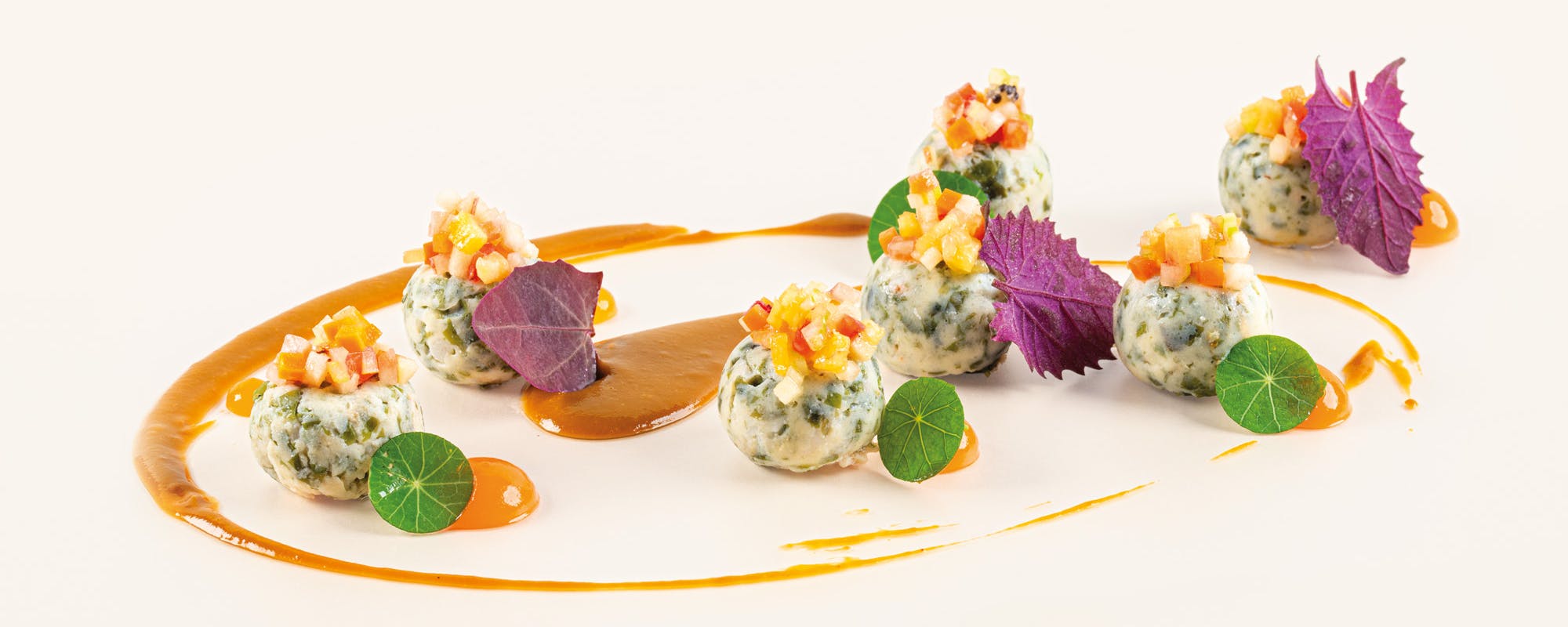a symphony of forest and sea
Beaches and forests. Sand and marble. Fish, but as well tubers, mushrooms, herbs, high-altitude fruit and vegetables. The local cuisine delves into this diverse treasure trove of products, crafting unique symphonies of flavors that blend the essence of the mountains and the sea. Let’s explore these culinary masterpieces orchestrated for us by some of the most renowned chefs from the Riviera
Words Irene Arquint - Photography Gabriele Ancillotti
Theirs is a perfect union, just like the sun and the moon coexist without obscuring each other’s beauty but rather complementing one another. Versilia’s hallmarks are not just beaches but also green forests where you can find relief from the heat, beyond which you climb to the top. Turning away from the waves, the magnificent vista of the Apuan Alps opens wide. Similarly, clambering up there on the Pania, Croce and Gabberi mountains, your gaze embraces the coast and the islands. This dual soul of sea and mountain does not escape the hand of chefs who shape the raw material. Be it mackerel, wild herbs, anchovies, chestnuts, sea or land snails, mullet, and local bread, even at the table, Versilia proves how much beauty lies in the opposites that together forge the magic of these places.
Sgombro al caffè, panna cotta di lumache, mela cotogna e caviale
Valentino Cassanelli set up a “conversation” between mackerel and snails, quince, and caviar to be found in one of his ideal inland journeys at the Lux Lucis restaurant. Sure enough, he did it by experimenting. Thus, after harvesting it in the winter, he placed the wild apple to ferment so as to bring an acidic component to the mackerel marinated in the morning scents (the Moka coffee), paired with a land snail panna cotta.
La maruzzella va in collina
The queen of vegetable gardens and orchards retakes center stage in a new setting, carried off from the waves this time. Michele Mascia of Bagni di Villa Grey takes a backward route by making sea snails climb the hillside. This itinerary is devoted to ravioli inspired by Gualtiero Marchesi, the chef who founded the new Italian cuisine. It creates a sauce that also includes pioppini mushrooms. The dough is infused with parsley leaf, borage flower, and nettle to color the pastry.
Passeggiando fra i sentieri fino al mare
Picking from the knolls one of the most widespread natural plants yet frowned upon by children’s legs – the nettle –, Enoteca Giulia turns it into a pesto paired with an oven-baked amberjack steak. Rounding out the inland embrace to the sea is the contribution of noppoli (a kind of wild asparagus), baby carrots, wild garlic, dandelion, and a leaf created with chestnut flour from Retignano (a village in Upper Versilia).
Tagliata di tonno con erbucci e cavolo frascone
As our chef ’s harvest basket is – by all odds – always full, we move to Pietrasanta, where Simone Andreano of Il Posto opted for the “erbucci” herbs to present with the now-historic sliced tuna steak in a very local twist. In galvanizing this identity, he fries it, then adds the Monk’s beard plant (a local sprig of the Versilian countryside cuisine) and frascone cabbage, a Brassicaceae flowering plant almost forlorn to itself in the fields.
Gnudi di gamberi con mirepoix di frutta e verdura e riduzione di erbi
Continuing our journey towards Marina di Pietrasanta, Alex’s Gabriele Polonia creates a reduction sauce of wild herbs instead. His dish carries us forward to a Versilia of yesteryear, represented by a modern fish casserole, where the gnudo maremmano (traditional Tuscan dumplings) recounts the chef ’s story. While sea lettuce replaces spinach, seasonal chopped fruit and vegetables evoke the iconic dish again.
Tagliolino delle Apuane
Alessandro Lucchinelli of the Village encapsulates the essence of the territory in a single nibble: weever (best known as the spiny fish that stings the bathers’ feet), Castagnetola lemons (a hillside hamlet of Massa), the Treschietto onion from the Lunigiana area and the Montignoso bread (cornmeal, genuine olives, chili peppers and a blend of Mediterranean flavors). The outcome is a classic Italian taste dipped into the chronicles of this Tuscan branch.
Triglia, tarassaco e capperi di sambuco
Last but not least, back in Forte, we find Alessandro Ferrarini of the Sciabola, who had climbed to the Garfagnana region to refill his basket with elderberry capers. The hallmarks of his recipes are always a savory note (the sea), a bitter one (the dandelion sauce), and an acidic one (the elderberry caper). The ensemble of the three elements culminates in perfection in a mullet in which the Apuan Alps ideally re-embrace the beach. Because in Versilia, whether with a glance or a bite, sea and mountains are one.
Many thanks to: Lux Lucis, Forte dei Marmi | Bagni di Villa Grey, Forte dei Marmi | Enoteca Giulia, Forte dei Marmi | Sciabola, Forte dei Marmi | The Village, Marina di Carrara | Alex, Marina di Pietrasanta | Il Posto, Pietrasanta
